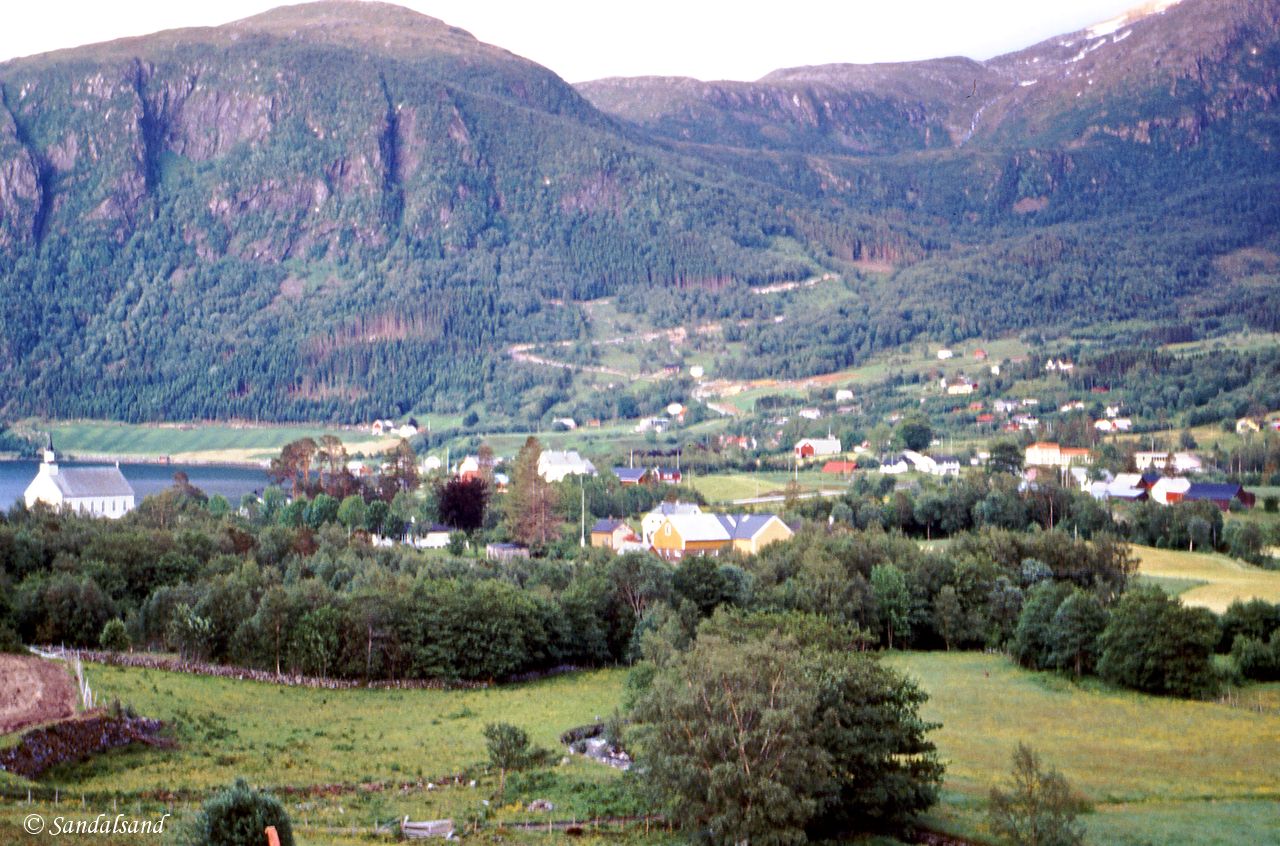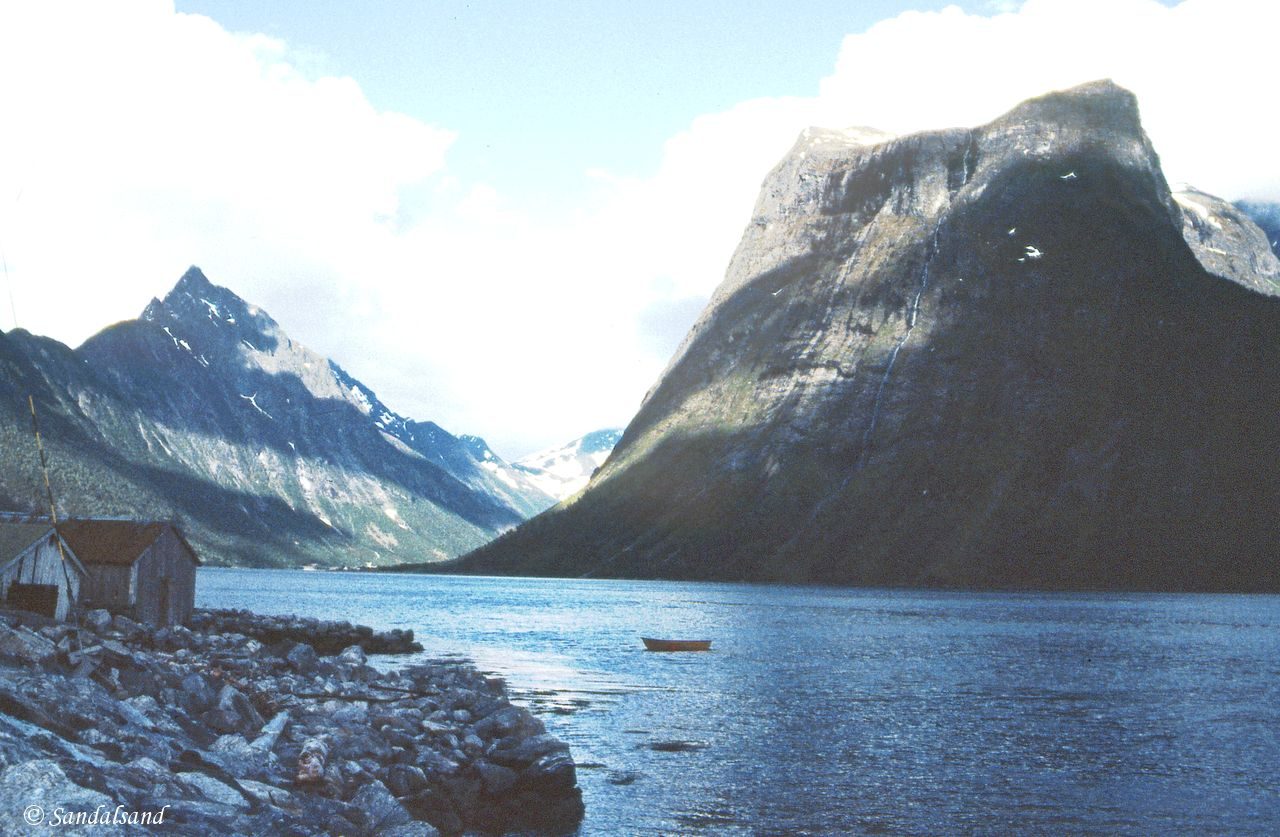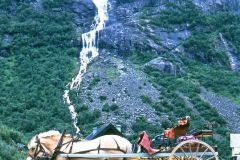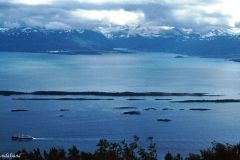The first article from a road trip around southern Norway covers the west coast, the fjord country, from Stavanger to Molde.
This is one of four articles from a road trip in the four regions of southern Norway. In three weeks we will be driving almost 3,000 kilometres (1,800 miles). It’s an amazing journey, so read up on the introductory article before you proceed.
This article was first published in Norwegian, on Sandalsand Norge.
Introduction
To foreigners, Norway is almost synonymous with the West Coast. Here we find high snow-capped mountains plunging straight into the deep fjords. Here we find small farms clinging to steep cliff walls, and here we find bordering on the ocean an archipelago almost without equal.
It’s not difficult to spend an entire summer on the road on the west coast (Vestlandet). This article will primarily deal with the northern part, the counties of Sogn og Fjordane and Møre og Romsdal. The reason is that we had a long way to go, and we were reasonably familiar in the south of the “Fjord country”. If you want to read up on other road trips in Western Norway, I will recommend starting in the south with the Boknafjord, in Rogaland county. In Hordaland county we find Hardanger, another great road trip in scenic surroundings. A third trip went to what the very heart of Western Norway, the inner districts of Hordaland and Sogn og Fjordane.
Fast north from Stavanger
When we therefore turn our attention to our starting point, Stavanger, we will make some quick leaps forward. We followed the main road along the coast, E39, and made only a brief stop just before Bergen, at composer Edvard Grieg’s famous home Troldhaugen.

Troldhaugen was the home of Edvard Grieg
If you have more time available, you should include Karmøy and Haugesund on your way north, and perhaps also a detour to include Kvinnherad and the Barony in Rosendal. We continued speedily through Bergen (Bryggen is a World Heritage Site), and found us a B&B for the night, somewhere along the road north. For tourists, Norway has always been blessed with favourably priced private accommodation. Perhaps there used to be more, but you will still find signs marked “Rooms, Zimmer” along the road. Nice and clean, and often in beautiful surroundings.
Towards Nordfjord
The next day we continued north, passing Førde and turned west on National road 5, away from the main road. My partner had visited Florø previously and provided an enthusiastic description of the small town close to the mighty ocean. Thus, we made it a slight detour on our journey towards Nordfjord. Florø showed its best side this day, with blue skies and brilliant sunshine. It is a nice little port town, full of quaint old wooden houses. It was well worth the detour.

Florø
But then there was Nordfjord coming up, the northernmost of the fjords in Sogn og Fjordane. From Florø you backtrack a few kilometres and then turn left on County road 665 towards Svelgen. The road climbs up into the open and free territory before descending again towards our final stop this day at Nordfjord.

View of Nordfjord
For other road trippers our goal for the day might be the most attractive destination. Davik is a small hamlet in a beautiful bay, adorned with a pretty white painted church. It is quiet here, but we came primarily to meet friends and to stay the night.

It is perhaps an exaggeration to call Davik more than a hamlet, but the setting is nice.
The next day we headed into Nordfjord. We were unsure how far we would get this day, but the idea was to drive roughly due east in the direction of the small town of Nordfjordeid, then the very long lake of Hornindalsvatnet and further south towards the innermost part of the Nordfjord, where it aptly changes its name to Innfjorden. Here we pass a number of rural towns: Stryn, Loen and Olden.
Hornindalsvatnet provides a nice scenery, and is deep too. It has been measured to be 514 metres at the deepest and you will not find a deeper lake anywhere in Europe. There is also supposed to be a sea serpent lurching in the abyss.
Here are some photos of places mentioned above. We were just passing through, because we were on our way to one of Norway’s premier attractions.
Briksdalsbreen

The Briksdalsbreen glacier
Norway as a tourist destination was opened up at the end of the 1800s, and Briksdalsbreen was one of the first and biggest attractions. Farther south in western Norway excursions to the Folgefonna glacier drew tourists to Odda, in fact every other tourist to Norway went there in the early 1900s. Briksdalen, the inner part of the Olden Valley, continues to lure hundreds of thousands of visitors every year.
One can drive pretty far into the valley, but from the parking lot one must either walk – as we did – or be driven most of the 2.5 kilometres to the glacier’s rim. In the old days, one could go by carriage pulled by the old Norwegian horse breed Fjording. After 2003 the horses have been replaced by so-called Troll Cars, a motorized means of transport of a far less picturesque character.
The glacier is a wonderful sight. From an altitude of more than 1,200 metres this arm of Norway’s largest glacier, Jostedalsbreen, stretches approximately 800 metres down the mountainside. There have been measurements of the glacier’s expansion since the year 1900, and the results show that it has had varying lengths throughout the century – both increases and decreases. Due to the danger of calving we are cautioned against approaching the ice itself, and ropes had been set up when we arrived. Some visitors continued even further, but we chose to follow the recommendations. The view is nevertheless formidable.
Click to see images below in a larger size.
Geiranger
Our next destination is not less known among Norwegian and foreign tourists.
The Geirangerfjord is even particularly mentioned (along with the Nærøyfjord) in UNESCO’s description of the world heritage site “West Norwegian Fjords“. We went back the same way, via Olden, Loen and Stryn. Here we took National road 15 east to Oppstryn at the end of the lake with the same name and continued further up into the mountains.
Here we may insert the map of this comprehensive road trip in southern Norway. Note that the map is “interactive” in that you can zoom in and out, and even open it in full screen. If you zoom in on the area that is described here, you will see that the map contains an error. Google refuses to plot this part of our itinerary. We followed the road from Stryn to Grotli and then down the National road 63 to Geiranger at the end of the fjord. Google insists on drawing the route via Hornindal and Hellesylt, adding a return ferry trip on the fjord.
The map
It must be mentioned that the road to Grotli is on the new main road through a series of tunnels. In summer the “old road” is open across the Strynefjellet mountain, passing by a summer ski resort. But anyway, we were going to fork at Grotli and would thus ascend from sea level at Stryn to about 1000 metres altitude and then down a serpentine road to sea level in Geiranger. This is a brilliant trip, in summer, with some absolutely fantastic viewpoints down towards Geiranger. The snow walls were still several metres high along the road when we got up in the mountains this summer.
The centre of the Geiranger village proved to be a little disappointment. Here we find some shops and places to stay the night, but it was not particularly exciting or picturesque in itself.

A glance back at Geiranger. We are leaving on a ferry on the fjord
On the other hand, the fjord is a revelation, and it is not without reason that it every year is high on the priority list when cruise lines set up their sailing plans for the Norwegian coast. We got a place on the car ferry.
It’s a majestic scenery, with huge vertical rock faces that plunge straight into the fjord. Some of the world’s most memorable waterfalls are found here, and mountain farms. “The Seven Sisters” are seven falls close together. On the side of them we can barely notice the small mountain farm of Knivsflå high on the mountain. On the opposite side we find the waterfall “Suitor” (the Friar) with the farm Skageflå next to it. If you have time to spend, you will surely find joy in the climb up there.
Farther out, we find a beautiful waterfall, appropriately named the “Bridal Veil”.
Here are more pictures from Geiranger.
Sunnmøre
It was after leaving Grotli (Oppland county) that we entered Møre og Romsdal county. Geiranger too belongs to the region of Sunnmøre, but we will go deeper into this region.
The road from Hellesylt leads us past the famous Union Hotel in Øye in Hjørundfjord. Then we take the ferry across the fjord from Leknes to Sæbø, and finally Volda. There we had relatives waiting for us, but even for those who do not have such hospitality in wait, Volda an interesting place to stop. The university college sets its marks on life here, as does the hospital – and both have done so for many years. We are in the heartland of Sunnmøre, heavy with traditions and culture.
We will continue, past Ørsta and the birthplace of Norwegian poet and creator of one of Norway’s languages, Ivar Aasen. Coming up next is the capital of Sunnmøre, Ålesund.
Ålesund is one of Norway’s most beautiful cities. The location is simply brilliant, it is especially lovely to stand on the mountain of Aksla and look down. Visitors are struck by the outstanding architecture of the old down-town area. Art Nouveau is not unknown in Norway, but the scope here is of a completely different calibre. Besides, the history of it is not least intriguing. Read the article about Ålesund.
Romsdal
Møre og Romsdal is a county that is not only a complexity by name but also in fact. The three old districts (Sunnmøre and Nordmøre with Romsdal right in between) are not always interacting in benign competition, neither historically or in the present.
We will leave that up to the locals, because we seek experiences and places. First is Åndalsnes. We are able to drive there from Ålesund without having to cross a fjord by ferry. Åndalsnes is located deep inside the Romsdalsfjord, and is the terminus for the Rauma Railway that runs up to Dombås (and to Oslo). The city is not in itself exciting. We had however family to visit, and moreover, we found Trollveggen slightly up in the valley. It is also not far from the famous hairpin bends of Trollstigen – but we did not go there. (It is not a long drive, so perhaps we should have done it.)

Nature is powerful in Western Norway. Here we have Trollveggen straight ahead (“Troll Wall”). These days they do base jumping down that cliff face.
We are now ready for the final leg of this first part of our road trip. We are going to Molde. This is a modestly interesting town for a traveller. Molde too offers a mountain view, though not quite the same as Aksla. In fact the best view from Molde’s mountain is the beautiful panorama towards the mountains of Sunnmøre.
Did you know that Norwegian poet Bjørnstjerne Bjørnson grew up here in Romsdal? Here is an excerpt from his poem “Romsdalen” in my own translation.
Further reading
Thus we have come to an end, for the moment, after 1073 kilometres. The drive continues with the story of the journey through Nordmøre, Trøndelag and all the way down eastern Norway. This article series of four ends with the south of Norway. The chapters are made to divide the presentation into bite-sized chunks. When you have read this far and seen the pictures, you will have understood that this road trip took place some years ago. It was in 1993, so have a little extra look at the introduction chapter.
Here are the chapters in this series:





































